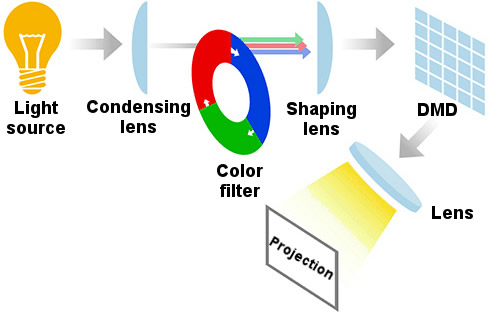What is the difference between DLP and LCD projectors?
DLP and LCD are the 2 main types of technologies used in digital projectors to create an image. They both rely on a separate light source, such as a projector lamp, to create the light, while the LCD or DLP system creates the colour and adjusts brightness to achieve the desired picture.

In an LCD (liquid-crystal display) projector, light from a single lamp is directed to a trio of miniature LCD panels that process the red, green, and blue light components separately. The pixels in each panel contain a liquid-crystal material that regulates the amount of light passing through them by twisting and untwisting in response to electrical voltages. After exiting the LCD panels, the three coloured beams are combined by a prism and projected onto the screen by a lens.

A typical DLP (Digital Light Processing) projector features a DMD chip (containing hundreds of thousands of tiny mirrors), plus a colour wheel (containing many colour segments such as Red, Green, Blue, Yellow, and White). When the projector powers on, the colour wheel commences spinning at a calibrated speed, essentially chopping the light into the individual colours on the wheel. The coloured beams of light then reflect off the DMD chip, where microscopic mirrors pivot many times a second to control the brightness of each projected pixel. The pivoting mirrors are synchronized with the colour wheel to ensure each pixel appears the right colour and at the right brightness. From here the light is projected through the lens and onto the projector screen.
DLP Projection

LCD Projection
